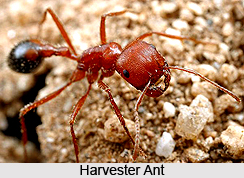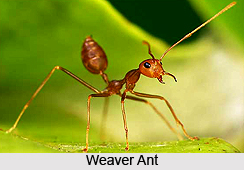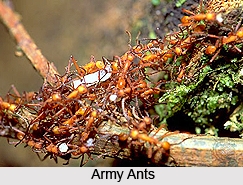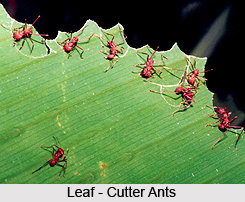 Ants are the most numerous and familiar among insects. It comprises one of the most highly evolved social forms of life in the planet, the ant colony consists of winged males and females and the apterous castes of workers. These wingless, terrestrial insects are characteristic in possessing a noticeable `waist`, formed of the first two or three abdominal segments. Another well known feature of ants is the presence of a sting at the tip of the abdomen. Man is by now very familiar with the general appearance of an ant and it would not be incorrect to say that both man and the ants are competitors today for the status of the dominant form of society with a complex social life. It is estimated that about 10,000 to 20,000 species of Formicidae (the ant family) exist all over the world and already about 700 species are known from Indian subcontinent, which is probably less than half of the actually existent ant fauna here.
Ants are the most numerous and familiar among insects. It comprises one of the most highly evolved social forms of life in the planet, the ant colony consists of winged males and females and the apterous castes of workers. These wingless, terrestrial insects are characteristic in possessing a noticeable `waist`, formed of the first two or three abdominal segments. Another well known feature of ants is the presence of a sting at the tip of the abdomen. Man is by now very familiar with the general appearance of an ant and it would not be incorrect to say that both man and the ants are competitors today for the status of the dominant form of society with a complex social life. It is estimated that about 10,000 to 20,000 species of Formicidae (the ant family) exist all over the world and already about 700 species are known from Indian subcontinent, which is probably less than half of the actually existent ant fauna here.
The caste system is well developed in ants, as in other social insect groups like the bees and termites. The female castes are the queen and the worker. The queen is the largest individual in the colony. It bears wings and a bulky gaster. The worker caste lacks wings and apart from the `neck` the entire body is one solid piece without any flexible joints besides the wings and legs which are the appendages. There may be major, minor and intermediate forms of the worker caste with functional mandibles and eyes sometimes absent. The soldier phase, if present, is larger than the worker and has a relatively bigger head, sometimes very disproportionate to the rest of the body. They function mainly as defenders of the nest, usually against other ants. In some species, various wingless intermediates occur between the minor worker and the queen castes. These are called the ergatoids, which may live along with the true queen in the nest and even replace her if necessary as the reproductive. The males are mostly winged throughout their life and are usually in between the queen and the worker in size, have large eyes and relatively small heads. One other noticeable feature of all castes of ants is the geniculate or elbow-like antennae.
 Like termites, winged males and females of the ant family also emerge from the nest and fly in a mass `nuptial flight` in particular months of the year, fixed for each species. Mating occurs in flight and then the pair descends to the ground, the male wandering about until he dies while the queen-to-be searches for a suitable place to nest. She constructs a chamber and lives there to create a new colony. Some queens, sometimes with a few workers, may invade the nest of another ant species, and take it over by killing that colony`s queen, and living as social parasites. This may only be a temporary take-over or ultimately the queen that took over the nest may replace that nest with her own progeny to make it an independent colony of her own. However, in some cases, the invading ant species may be a permanent parasite and live in the nest of the other species by making them its own `slaves`. This interesting association between two ant species is in many cases obligatory because the parasite species is not able to survive and reproduce without its `slaves`. When the slave species numbers in the nest deplete, workers of the `master` species raid the nearby nests of the slave species and carry back to their nest the pupae of the slave species to rejuvenate the slave colony.
Like termites, winged males and females of the ant family also emerge from the nest and fly in a mass `nuptial flight` in particular months of the year, fixed for each species. Mating occurs in flight and then the pair descends to the ground, the male wandering about until he dies while the queen-to-be searches for a suitable place to nest. She constructs a chamber and lives there to create a new colony. Some queens, sometimes with a few workers, may invade the nest of another ant species, and take it over by killing that colony`s queen, and living as social parasites. This may only be a temporary take-over or ultimately the queen that took over the nest may replace that nest with her own progeny to make it an independent colony of her own. However, in some cases, the invading ant species may be a permanent parasite and live in the nest of the other species by making them its own `slaves`. This interesting association between two ant species is in many cases obligatory because the parasite species is not able to survive and reproduce without its `slaves`. When the slave species numbers in the nest deplete, workers of the `master` species raid the nearby nests of the slave species and carry back to their nest the pupae of the slave species to rejuvenate the slave colony.
Communication in ants and the way they orient themselves has been studied with great interest by scientists. Known methods of communication are those by smell through the release of a chemical known as a pheromone which is volatile in nature and is secreted by a gland, and, when released upon a specific stimulus, evokes the desired response. Ants also communicate by the medium of taste, during exchange of food by workers or other castes. Tapping, and stridulation which constitutes rubbing portions of the body against each others also communicate sounds that mean something to the ants, while other signals may be shared by rubbing antennae together between two ants, and, in species that have well formed eyes, visual communication is another source of contact.
The nests that ants build are usually permanent, and formed mainly under the ground or in wood or existing cavities in rocks, etc. Each ant has a peculiar nest structure and some nests have characteristic ornamentations around their entrances above the soil surface. Some ants, like species of Polyrhachis, Crematogaster and Oecophylla, construct nests on trees with plant fibre or leaves. Another interesting abode of ants is in the stems and hollows in other parts of some epiphytic plants that act as `ant houses` and some sort of symbiotic relationship is known to exist between the plant and the ant.
 Ants are usually omnivorous scavengers, feeding on plant and animal matter alike. But some species may be specific predators, concentrating on special prey like spiders and their eggs, collembolans, termites, etc. Some genera like the very abundant Pheidole are called `harvester ants` because they depend to a great extent on seeds that are `harvested` by the colony and stored in the nests for food. Again, ants tend their `cattle` in the nest or outside in lieu of the sweet honeydew that aphids and other bugs produce, they voluntarily protect these insects from their predatory and parasitic enemies. Several plants have their extra floral nectarines which supply ants with food, and ants are also adept at sipping nectar from flowers of a great variety of plants. Some species of ants have workers that lay special eggs that are used only as food for the youngest larvae and the queen.
Ants are usually omnivorous scavengers, feeding on plant and animal matter alike. But some species may be specific predators, concentrating on special prey like spiders and their eggs, collembolans, termites, etc. Some genera like the very abundant Pheidole are called `harvester ants` because they depend to a great extent on seeds that are `harvested` by the colony and stored in the nests for food. Again, ants tend their `cattle` in the nest or outside in lieu of the sweet honeydew that aphids and other bugs produce, they voluntarily protect these insects from their predatory and parasitic enemies. Several plants have their extra floral nectarines which supply ants with food, and ants are also adept at sipping nectar from flowers of a great variety of plants. Some species of ants have workers that lay special eggs that are used only as food for the youngest larvae and the queen.
The habit of foraging for food is one of the most interesting of all ant activities. The way the ants orient towards the food source and come back with their `harvest`, vegetable or animal, involves orientation to and from the nest. This is done in two main ways: by each individual ant learning locations of restricted feeding zones and finding its way to and fro repeatedly, and by following `ant-trails` using a chemical substance. The trail is made by workers which find spots with plenty of food and mark their paths to it and back to the nest by a chemical scent. Depending on the particular species, foraging is usually restricted either to daytime or to nights, but it seems that temperature and relative humidity also are important factors.
 The size of a colony of an ant is very variable, from as few as a dozen individuals to as many as a million of them. The average size of a colony is around 2000 ants. As many as 200 species of ants may inhabit a square kilometre in tropical rain-forest and a single rotting tree log may harbour 25 or more ant nests. Considering their abundance in sheer numbers and the habitats that they exploit on earth, ants are certainly very important elements in our environment and deserve more attention than has been bestowed on them by man so far. Though most species are general feeders, many others are undoubtedly important natural enemies as predators of several other insects and other forms of life. Their role in the turnover of soil is little appreciated though they do a lot of good to man in bringing subsoil to the surface and in formation of soil. On the negative side, some harvester species of ants may cause some damage by restricting their area of activity near agricultural areas and raiding the crops for plant matter. However, their habit of `tending their cattle" like aphids and mealy-bugs and protecting them from their enemies, is far more injurious to man`s interests. But the presence of ants in man`s habitations is what is most annoying to him, especially as many of these species possess painful stings.
The size of a colony of an ant is very variable, from as few as a dozen individuals to as many as a million of them. The average size of a colony is around 2000 ants. As many as 200 species of ants may inhabit a square kilometre in tropical rain-forest and a single rotting tree log may harbour 25 or more ant nests. Considering their abundance in sheer numbers and the habitats that they exploit on earth, ants are certainly very important elements in our environment and deserve more attention than has been bestowed on them by man so far. Though most species are general feeders, many others are undoubtedly important natural enemies as predators of several other insects and other forms of life. Their role in the turnover of soil is little appreciated though they do a lot of good to man in bringing subsoil to the surface and in formation of soil. On the negative side, some harvester species of ants may cause some damage by restricting their area of activity near agricultural areas and raiding the crops for plant matter. However, their habit of `tending their cattle" like aphids and mealy-bugs and protecting them from their enemies, is far more injurious to man`s interests. But the presence of ants in man`s habitations is what is most annoying to him, especially as many of these species possess painful stings.
Ants have a number of their own predatory enemies, most common being the well known `anteaters`, several birds and lizards. Among insect enemies, the `antlions` thai form an ingenious conical pit in the sand and devour many a hapless ant. Almost all other insect groups have species that prefer feeding on ants, but ants themselves are in the habit of eating other ants. There are some tiny parasitic wasps that attack ants and ants are host to several other parasites including nematodes and fungi. Undoubtedly the most important enemy of the termites or `white ants` is the ants and many species specialize in termites for their major food item.
The most important `harvester ants belong to the genera Phidologeion, Pheidole and Holcomyrmex. One type of ant that is extremely ferocious and hunts in huge `drives` usually commencing in the late evening and continuing through the night, is the genus Leptogenysy which can sense the occurrence of a tasty morsel from a good distance lying underground and excavate it and then carry parts of it away after meticulously shredding the poor victim to tiny pieces and making it convenient to carry back home. Species of Monomorium and Solenopsis geminata are commonly introduced by man into his warehouses to control termites. Other common genera found in India are Tetraponera, Dorylus, Polyrhachis, Aenictus, Tapinoma and Acantholepis, to mention just a few.
Lastly, ants are mimicked by a peculiar group of spiders, sphecid wasps and several other wasp families, lygaeid and coreid bugs and even beetles. Beetles of the subfamily Paussinae share a special relationship as they are carefully looked after by ants in return for goodies which they give ants.



















